Performance—Based Route Selection for Mountainous Highways: A Numerical Approach to Addressing Safety, Hydrological, and Geological Aspects
Abstract
:1. Introduction
- Geometric Design Evaluation: The evaluation will focus on ensuring that all horizontal and vertical alignment elements adhere to design standards and align with driving behavior. This involves assessing elements such as horizontal curve length, radius, consecutive horizontal reverse curves, vertical curve designs incorporating stopping sight distances, allowable maximum and minimum grades, etc.
- Hydrological Aspects: Attention will be given to hydrological aspects to ensure the long-term stability of the highway. This involves considerations related to water flow, drainage, and other water-related factors that could impact the road’s structural integrity over time.
- Geological Aspects: Geological aspects will be examined to identify the rock type and properties of the study area. This information will be significant in determining the most suitable road path and addressing geological hazards that may affect the road’s construction and long-term stability.
1.1. Geometric Design Evaluation
1.2. Hydrological Aspects
1.3. Geological Aspects
1.4. Integrated GIS-Based Assessment
1.5. Research Objectives
2. Methodology
- Step 1: Determine crash risk factors using Fault Tree Analysis
- Step 2: DEMATEL process to determine weights of design parameters to calculate safety ratings.
- Step 3: GIS-based highway route selection
2.1. Determine Crash Risk Factors Using Fault Tree Analysis (FTA)
2.1.1. Driver Error
2.1.2. Vehicle Instability Due to Road Design
2.1.3. Hydrological and Geological Factors
Hydrological Investigations for Flood Hazard Mapping
- Rainfall Analysis: A comprehensive statistical analysis of rainfall data is conducted to develop Intensity-Duration-Frequency (IDF) curves and design storms, recognizing rainfall as the primary driver of streamflow and vital for flood protection projects.
- Catchment Delineation and Modeling: Digital Elevation Models (DEMs) with 30 × 30 m resolution are used to delineate streams and their corresponding external catchment areas impacting the proposed road alignments. A hydrological model is then constructed using HEC-HMS software to estimate runoff flows and hyetographs for the delineated catchments.
- 2D Floodplain Modeling: Leveraging outputs from the hydrological model and high-resolution DEMs, a 2D model is developed in HEC-RAS to accurately map floodplains, water depths, and velocities. This information serves as the foundation for flood hazard assessment, with the rain-on-grid approach adopted to capture the nuances of flood characteristics within each stream segment.
- Existing Flood Protection Structures: To comprehensively assess the flood risk for both the existing and proposed highway alignments, a thorough survey of existing flood protection structures was conducted. This evaluation helps in understanding the effectiveness of the current infrastructure against flooding events. Additionally, the survey will guide the integration of these structures into the design of the proposed alignments, ensuring they capitalize on available flood mitigation measures while minimizing potential disruptions during construction. A factor measuring this aspect will be considered in the proposed technique.
- Flood Hazard Assessment: Recognizing the multifaceted nature of flood hazards, beyond flow characteristics, a comprehensive approach is implemented. While water depth and velocity remain the primary indicators, additional social, economic, and environmental factors are considered, albeit challenging to quantify. A bespoke code, utilizing the WRL formula and water depth/velocity data at each HEC-RAS time step, is developed to calculate the flood hazard index. This index, ranging from 1 (low hazard) to 6 (high hazard), is subsequently normalized to a scale of 1–10 for integrated analysis, as shown in Table 2.
Geological Criteria (Lithology and Lineaments Elements)
2.2. Determining Design Parameters Weights
2.2.1. DEMATEL Process
- Step 1: Formulation of MatricesThe process begins by creating three matrices: the direct-relation matrix (Z), the normalized direct-relation matrix (X), and the total-relation matrix (T) are formulated as shown in Equations (1)–(3).
- Direct-Relation Matrix (Z): This matrix represents the direct influence of factor i on factor j. Each element is set to 1 if there is an influence, and 0 if there is not.
- Normalized Direct-Relation Matrix (X): The direct-relation matrix is normalized to form , ensuring that all values are between 0 and 1.
- Total-Relation Matrix (T): This matrix represents the overall influence and relationship among factors and captures both direct and indirect influences among factors. It is calculated using the formula:where (I) is the identity matrix or self-influencing factor, where diagonal elements equal to 1 and the remaining matrix is 0.
- Step 2: Determining Relative Importance and Net EffectIn this step, the distributing influence (Di) and receiving influence (Rj) for each factor are calculated.
- Distributing Influence (Di): This is the total influence of factor i on other factors, calculated as the sum of the i-th row of the total-relation matrix.
- Receiving Influence (Rj): This is the total influence received by factor j from other factors, calculated as the sum of the j-th column of the total-relation matrix.These values are then used to calculate the relative importance (qi) and net effect (ni) for each risk factor. Where:
- -
- Relative Importance (qi)qi = Di + Rj
- -
- Net effect (ni)ni = Di − Rj
The relative importance (qi) indicates how important each factor is in relation to others, with a larger value indicating a closer relationship and higher importance. The net effect (ni) classifies factors into causal (positive values) and resultant (negative values), where causal factors have more influence.
- Step 3: Normalizing Relative ImportanceTo facilitate comparison, the relative importance (qi) is normalized to derive the weight of each factor (wi). The weight indicates the factor’s impact on traffic safety, with higher weights indicating more significant effects.The normalized weight (0 to 1) of each factor is then calculated as:
2.2.2. DEMATEL Results
2.3. GIS-Based Highway Route Selection
- Step 1:
- Step 2:
- Next, the geometric and environmental characteristics are standardized by computing a normalized risk intensity value (RIN) ranging from 1 (indicating the lowest risk intensity) to 10 (representing the highest risk intensity). An example of Excel output is shown in Figure 5. Based on the value of the design factor (DFi), a corresponding risk intensity is assigned using the scale outlined in Table 1.
- Step 3:
- Subsequently, the tables are exported to GIS, where the threat score (TS) for each segment is determined by summing the products of the assigned risk intensities (RINi) and the weights associated with each design factor (Wi) as shown in Equation (10). These weights are established in the preceding DEMATEL step. An example of GIS output is shown in Figure 6.
- Step 4:
- For each alternative, the average Threat Score () is computed as shown in Equation (11) to determine the best alternative for consideration.
2.4. Mapping of Geological Elements
- Layer stacking of the different bands in the image.
- Subsetting of images to focus on the exact area required.
- Construction of false-color composite images (FCC) using band combination and band ratioing techniques to achieve optimal lithologic discrimination and identify lithological cover.
- Utilization of enhancement and merging techniques during processing, with images produced in the UTM projection (WGS84 datum, zone 36N).
- Application of Principle Component Analysis (PCA) to transform images by compressing the dataset and reducing the number of dimensions [31].
- Implementation of supervised classification, where distinct information categories are initially identified, is followed by an examination of their spectral separability. In contrast, the unsupervised approach involves the computer determining spectrally separable classes and defining their information value.
- Creation of a lineament map using PC images in the Geomatics platform, with a line density layer constructed in the ArcGIS environment.
- Conducting fieldwork and ground truthing to enhance the accuracy of the geological map.
3. Case Study (Quseir Road)
3.1. Evaluation of Existing Geometric Alignment of Quseir Road
- Sharp Horizontal Curves: Approximately 21% of the horizontal curves are characterized by sharp radii, indicating speeds below 85 km/h, when back-calculated using the balance equation. Specifically, out of 125 curves, eight curves (6% of the total) feature radii below 135 m, implying speeds between 45 and 55 km/h. Additionally, 11 curves (9%) have radii ranging from 145 m to 210 m, suggesting speeds between 55 and 70 km/h. Moreover, seven curves (6% of the total) exhibit radii between 215 m and 305 m, inferring speeds between 70 and 84 km/h.
- Short Horizontal Curves: The alignment includes extremely short horizontal curves, some as short as 15.5 m, resulting in kinks along the road. Research suggests that horizontal curve length (m) should ideally be three to six times the design speed (km/h), with an absolute minimum of 150 m. Within the 90-km section examined in this study, 47 curves (38% of the total curves in the alignment) have lengths less than 150 m.
- Large Angles of Deflection: Similarly, curves with large angles of deflection are undesirable as they can cause discomfort for drivers, particularly on sharp curves [34,35]. As an example, the existing alignment consists of two reverse curves between KM 26+994 and KM 28+470. At this distance, the two reverse curves have radii of 540 m and 460 m consecutively, with angles of deflection measuring 160 and 150 degrees, respectively. This configuration results in a reverse curve alignment spanning almost 1.5 km, coupled with sharp curvatures. The application of the Threat Score in this segment yields an average TSExisting of 2.5.
- Maximum Vertical Grades: AASHTO [20] specifies that the maximum vertical grades in mountainous regions, designed for speeds of 110 km/h, may reach up to 5%. However, considering the presence of severe combinations of horizontal and vertical curves, it is preferable to limit the maximum grade to 3%. Currently, 1% of the existing alignment consists of grades exceeding 3%, with a maximum grade of 4.5%.
3.2. Flood Plain Analysis of Quseir Road
- Hydrological Considerations: The catchment area, covering 2260 km2, experiences periodic flash floods during the winter, posing risks to road infrastructure. Analysis of rainfall data from Quseir rainfall stations spanning 34 years revealed that the maximum daily rainfall depth for a 100-year return period is recorded at 28.5 mm.
- Topographic Diversity: The road encounters a diverse topography characterized by distinct landforms and elevations. The road navigates through a series of wadis, or dry river valleys, that cut through the plateau, creating deep gorges and canyons. As the road progresses, the elevation of the terrain steadily rises, reaching a maximum of approximately 540 m above sea level near Qeft, the inland terminus of the road.
3.3. Geological Setting of Quseir Road
4. HRS Results
5. Contributions and Limitations
Author Contributions
Funding
Institutional Review Board Statement
Informed Consent Statement
Data Availability Statement
Conflicts of Interest
References
- World Health Organization. Global Status Report on Road Safety 2018: Summary; No. Who/nmh/nvi/18.20; World Health Organization: Geneva, Switzerland, 2018. [Google Scholar]
- Ma, L.; Yan, X.; Qiao, W. A quasi-poisson approach on modeling accident hazard index for urban road segments. Discret. Dyn. Nat. Soc. 2014, 2014, 489052. [Google Scholar] [CrossRef]
- Azari, M.; Paydar, A.; Feizizadeh, B.; Hasanlou, V.G. A gis-based approach for accident hotspots mapping in mountain roads using seasonal and geometric indicators. Appl. Geomatics 2023, 15, 127–139. [Google Scholar] [CrossRef]
- Yu, R.; Xiong, Y.; Abdel-Aty, M. A correlated random parameter approach to investigate the effects of weather conditions on crash risk for a mountainous freeway. Transp. Res. Part C Emerg. Technol. 2015, 50, 68–77. [Google Scholar] [CrossRef]
- Transportation Research Board. The National Academies of Sciences, Engineering, and Medicine. In A Performance-Based Highway Geometric Design Process; The National Academies Press: Washington, DC, USA, 2016. [Google Scholar]
- Zhang, H.; Zhang, M.; Zhang, C.; Hou, L. Formulating a gis-based geometric design quality assessment model for mountain highways. Accid. Anal. Prev. 2021, 157, 106172. [Google Scholar] [CrossRef] [PubMed]
- Jha, M.K.; Schonfeld, P. A highway alignment optimization model using geographic information systems. Transp. Res. Part A Policy Pract. 2004, 38, 455–481. [Google Scholar] [CrossRef]
- Castro, M.; De Santos-Berbel, C. Spatial analysis of geometric design consistency and road sight distance. Int. J. Geogr. Inf. Sci. 2015, 29, 2061–2074. [Google Scholar] [CrossRef]
- Blanton, P.; Marcus, W.A. Railroads, roads and lateral disconnection in the river landscapes of the continental united states. Geomorphology 2009, 112, 212–227. [Google Scholar] [CrossRef]
- Youssef, A.M.; Pradhan, B.; Hassan, A.M. Flash flood risk estimation along the st. Katherine road, southern sinai, Egypt using gis based morphometry and satellite imagery. Environ. Earth Sci. 2011, 62, 611–623. [Google Scholar] [CrossRef]
- Zhang, L. Engineering Properties of Rocks; Butterworth-Heinemann: Oxford, UK, 2016. [Google Scholar]
- Liu, J.; Cao, Z.; Li, X.; Wang, W.; Hou, J.; Li, D.; Ma, Y. Modelling urban flooding integrated with flow and sediment transport in drainage networks. Sci. Total Environ. 2022, 850, 158027. [Google Scholar] [CrossRef] [PubMed]
- Yang, J.; Townsend, R.D.; Daneshfar, B. Applying the hec-ras model and gis techniques in river network floodplain delineation. Can. J. Civ. Eng. 2006, 33, 19–28. [Google Scholar] [CrossRef]
- Ekblaw, G.E.; Grim, R.E. Some Geological Relations between the Constitution of Soil Materials and Highway Construction; Report of Investigations, No. 042; Illinois State Geological Survey: Champaign, IL, USA, 1936. [Google Scholar]
- Burgat, V.A. Application of geology in kansas highway construction. Trans. Kans. Acad. Sci. (1903-) 1964, 67, 301–306. [Google Scholar] [CrossRef]
- Hearn, G.J.; Pettifer, G.S. The role of engineering geology in the route selection, design and construction of a road across the blue nile gorge, Ethiopia. Bull. Eng. Geol. Environ. 2016, 75, 163–191. [Google Scholar] [CrossRef]
- Smugala, S.; Kubečková, D.; Indra, F. The impact of changes in the geological conditions of road bedrock layers while the road was in use. Organ. Technol. Manag. Constr. Int. J. 2019, 11, 2009–2021. [Google Scholar] [CrossRef]
- Sadek, S.; Kaysi, I.; Bedran, M. Geotechnical and environmental considerations in highway layouts: An integrated gis assessment approach. Int. J. Appl. Earth Obs. Geoinf. 2000, 2, 190–198. [Google Scholar] [CrossRef]
- Li, P.; He, J. Geometric design safety estimation based on tire–road side friction. Transp. Res. Part C Emerg. Technol. 2016, 63, 114–125. [Google Scholar] [CrossRef]
- AASHTO. A Policy on Geometric Design of Highways and Streets, 7th ed.; American Association of State Highway and Transportation Officials: Washington, DC, USA, 2018. [Google Scholar]
- ECP. Egyptian Code of Practice in Urban and Rural Roads; Ministry of Housing, Utilities and Urban Communities: Cairo, Egypt, 2023. [Google Scholar]
- Zhao, X.; Rong, J. The relationship between driver fatigue and monotonous road environment. In Computational Intelligence for Traffic and Mobility; Springer: Berlin/Heidelberg, Germany, 2012; pp. 19–36. [Google Scholar]
- Rosey, F.; Auberlet, J.-M. Trajectory variability: Road geometry difficulty indicator. Saf. Sci. 2012, 50, 1818–1828. [Google Scholar] [CrossRef]
- Marinos, V.; Carter, T.G. Maintaining geological reality in application of gsi for design of engineering structures in rock. Eng. Geol. 2018, 239, 282–297. [Google Scholar] [CrossRef]
- Hoek, E.; Brown, E.T. Practical estimates of rock mass strength. Int. J. Rock Mech. Min. Sci. 1997, 34, 1165–1186. [Google Scholar] [CrossRef]
- Onyango, J.A.; Sasaoka, T.; Shimada, H.; Hamanaka, A.; Moses, D.; Tumelo, D. Evaluating rock mass properties of vipingo coral limestone quarry based on a modified geological strength index (gsi) and state of karstification. Open J. Geol. 2022, 12, 57–79. [Google Scholar] [CrossRef]
- Ogrodnik, K. The use of the dematel method to analyse cause and effect relationships between sustainable development indicators. Econ. Environ. 2018, 67, 13. [Google Scholar]
- Tsou, P.-H.; Hsu, H.-Y. Applications of fishbone diagram and DEMATEL technique for improving warehouse operation—A case study on YMT overseas imported components. China-USA Bus. Rev. 2022, 21, 143–154. [Google Scholar] [CrossRef]
- Gobashy, M.M.; Eldougdoug, A.; Abdelwahed, M.; Abdelazeem, M.; El-Rahman, Y.A.; Abdelhalim, A.; Said, S. Role of integrated magnetics and geology in tracking and exploring complex structures controlling gold mineralization. Example from the fawakheir-atalla gold prospects, eastern desert, Egypt. Pure Appl. Geophys. 2023, 180, 2775–2805. [Google Scholar] [CrossRef]
- Abdelhalim, A.; Aboelkhair, H.; Hamimi, Z.; Al-Gabali, M. Mapping lineament features using gis approaches: Case study of neoproterozoic basement rocks in the south-eastern desert of Egypt. Arab. J. Geosci. 2020, 13, 651. [Google Scholar] [CrossRef]
- Gobashy, M.M.; Eldougdoug, A.; Abdelazeem, M.; Abdelhalim, A. Future development of gold mineralization utilizing integrated geology and aeromagnetic techniques: A case study in the barramiya mining district, central eastern desert of Egypt. Nat. Resour. Res. 2021, 30, 2007–2028. [Google Scholar] [CrossRef]
- Eldougdoug, A.; Abdelazeem, M.; Gobashy, M.; Abdelwahed, M.; El-Rahman, Y.A.; Abdelhalim, A.; Said, S. Exploring gold mineralization in altered ultramafic rocks in south abu marawat, eastern desert, Egypt. Sci. Rep. 2023, 13, 7293. [Google Scholar] [CrossRef] [PubMed]
- Abdelhalim, A.; Abuelella, I.; Sakran, S.M.; Said, S.M. Implementation of space-borne optical data and field investigation for geo-structural mapping of an interior rift basin: A case study from kharit area, southeastern desert, Egypt1037. J. Min. Environ. 2023, 14, 1037–1059. [Google Scholar]
- Ma, X.; Chen, F.; Chen, S. Modeling crash rates for a mountainous highway by using refined-scale panel data. Transp. Res. Rec. J. Transp. Res. Board 2015, 2515, 10–16. [Google Scholar] [CrossRef]
- Rusli, R.; Haque, M.M.; King, M.; Voon, W.S. Single-vehicle crashes along rural mountainous highways in malaysia: An application of random parameters negative binomial model. Accid. Anal. Prev. 2017, 102, 153–164. [Google Scholar] [CrossRef]
- Alexander, J.; Cooker, M.J. Moving boulders in flash floods and estimating flow conditions using boulders in ancient deposits. Sedimentology 2016, 63, 1582–1595. [Google Scholar] [CrossRef]

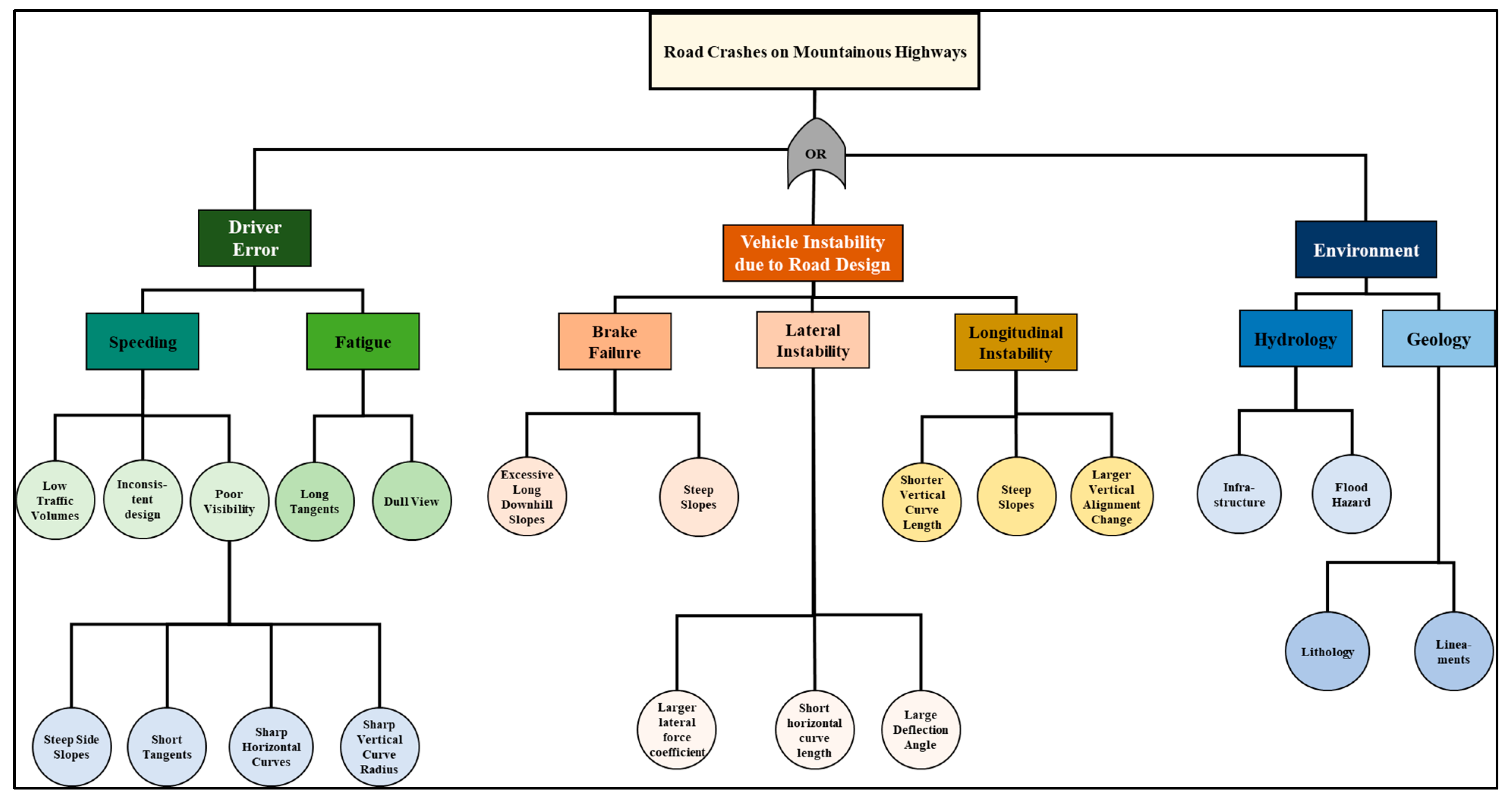
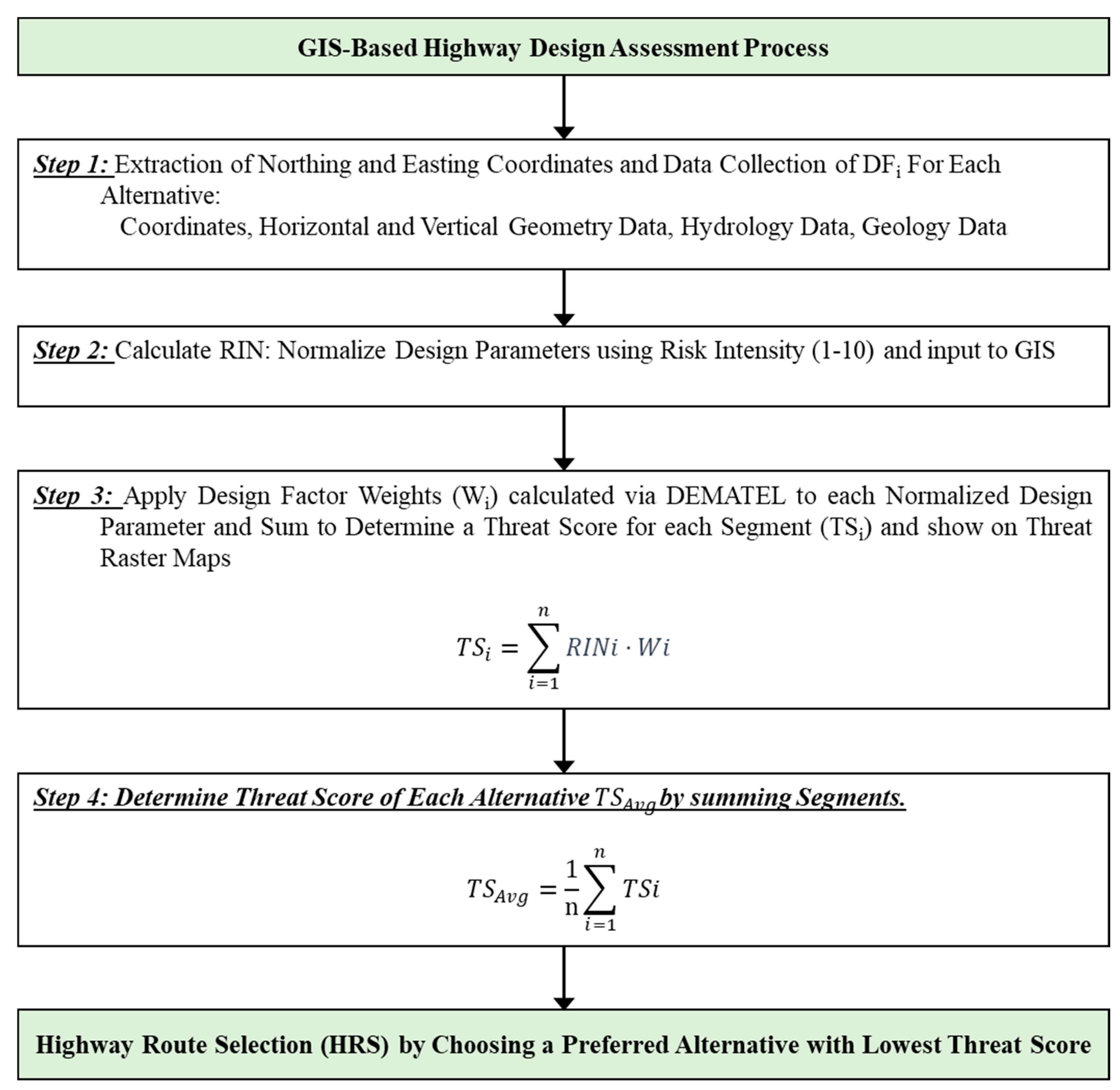



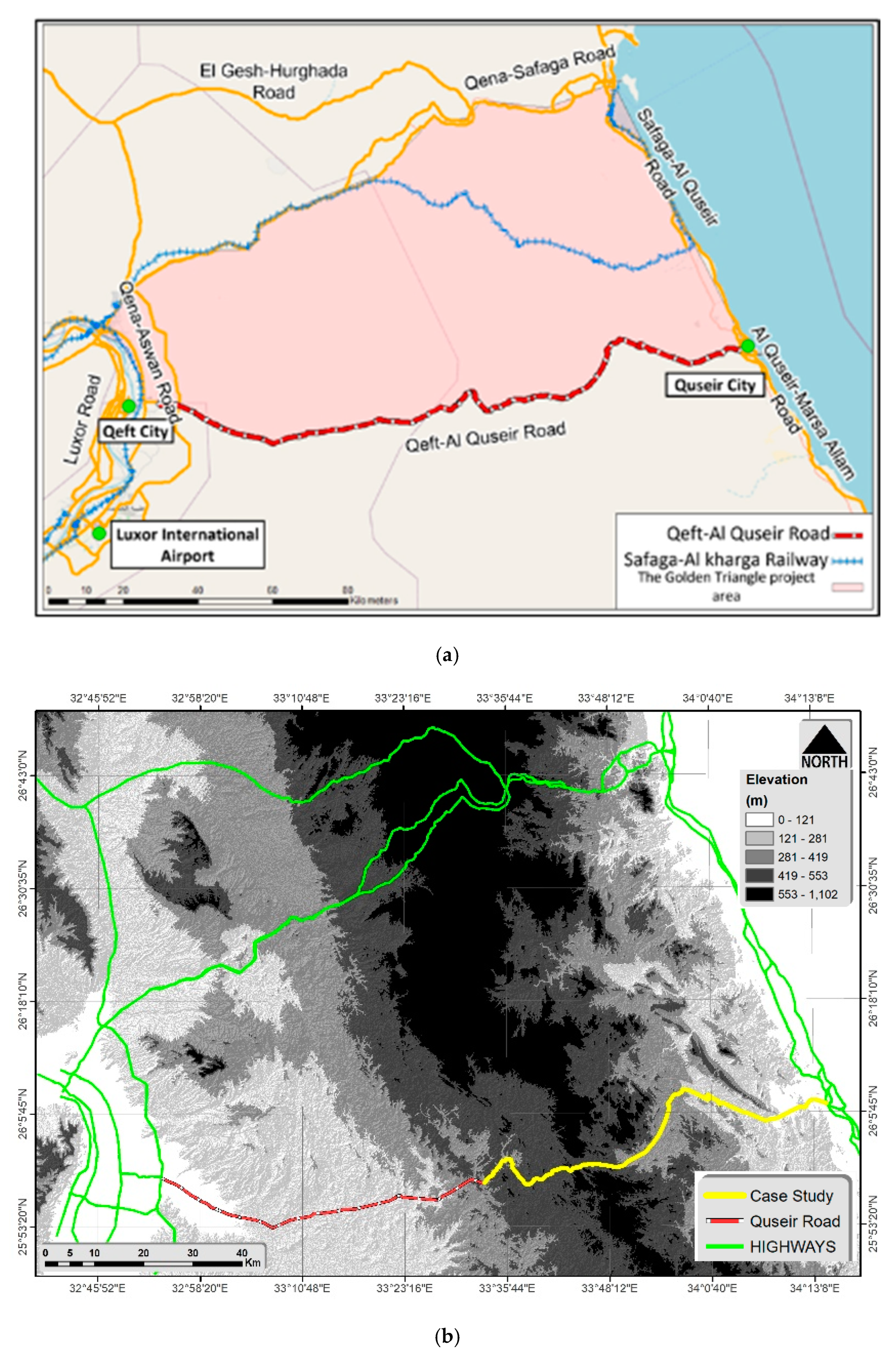
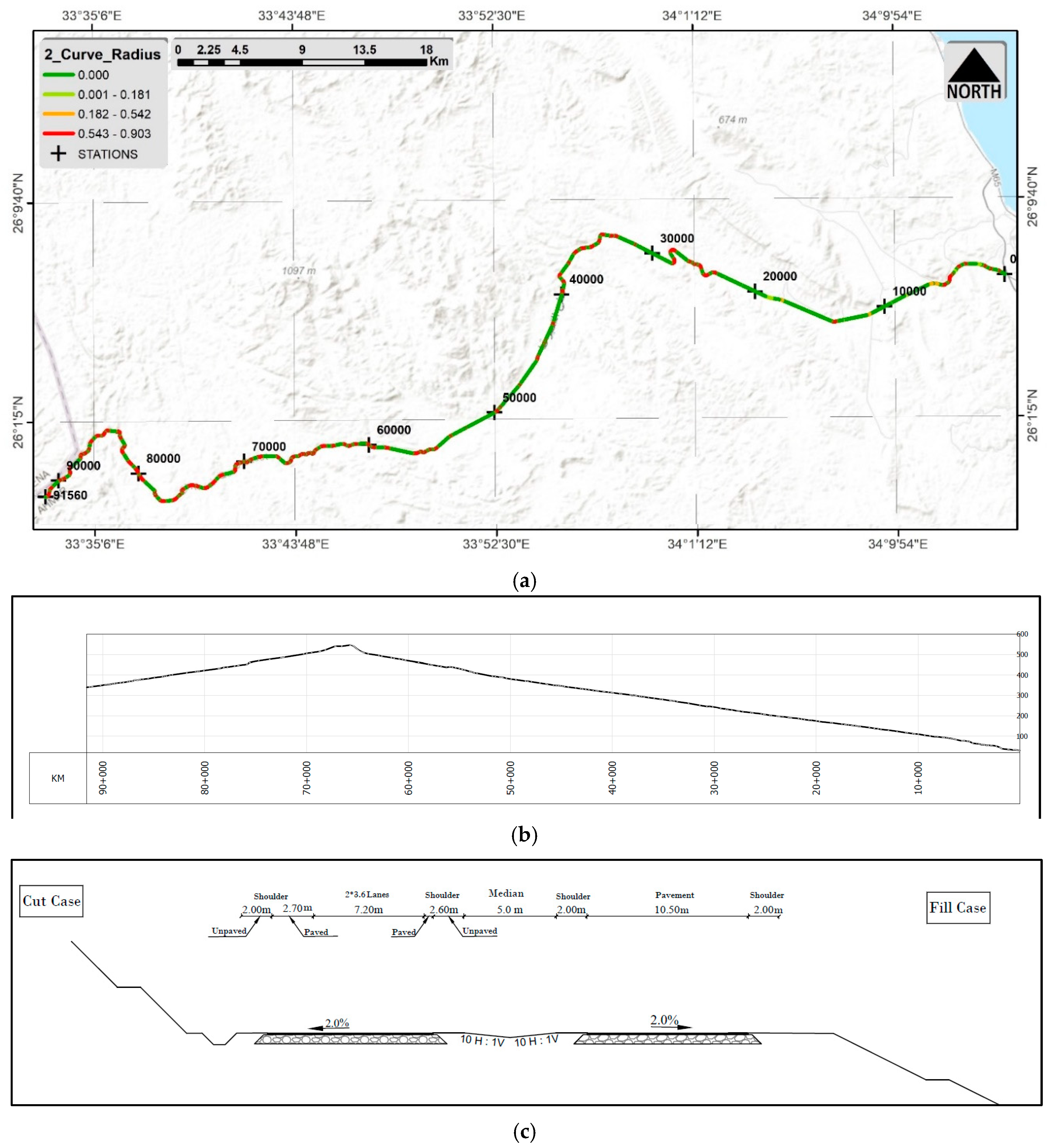

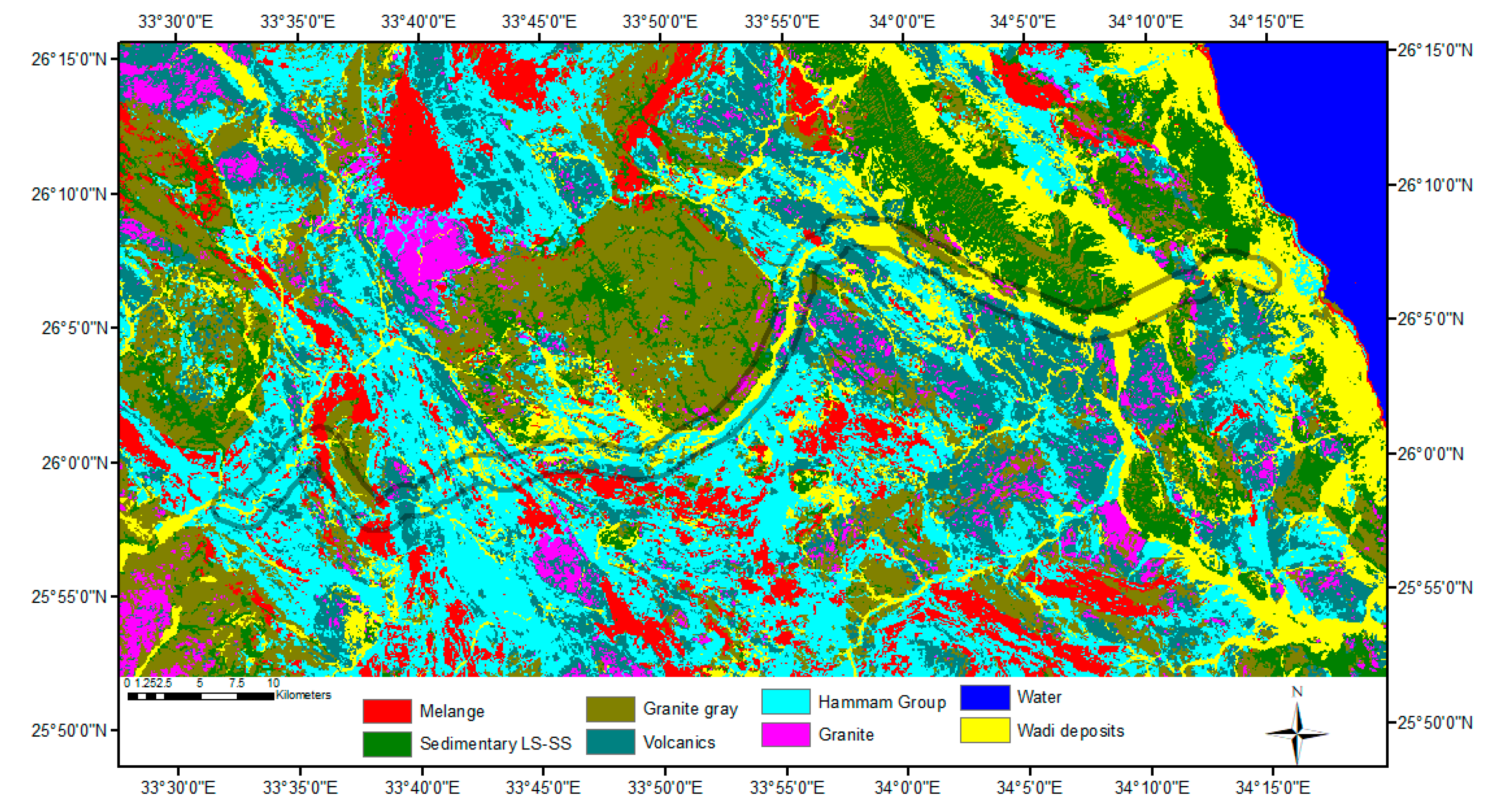
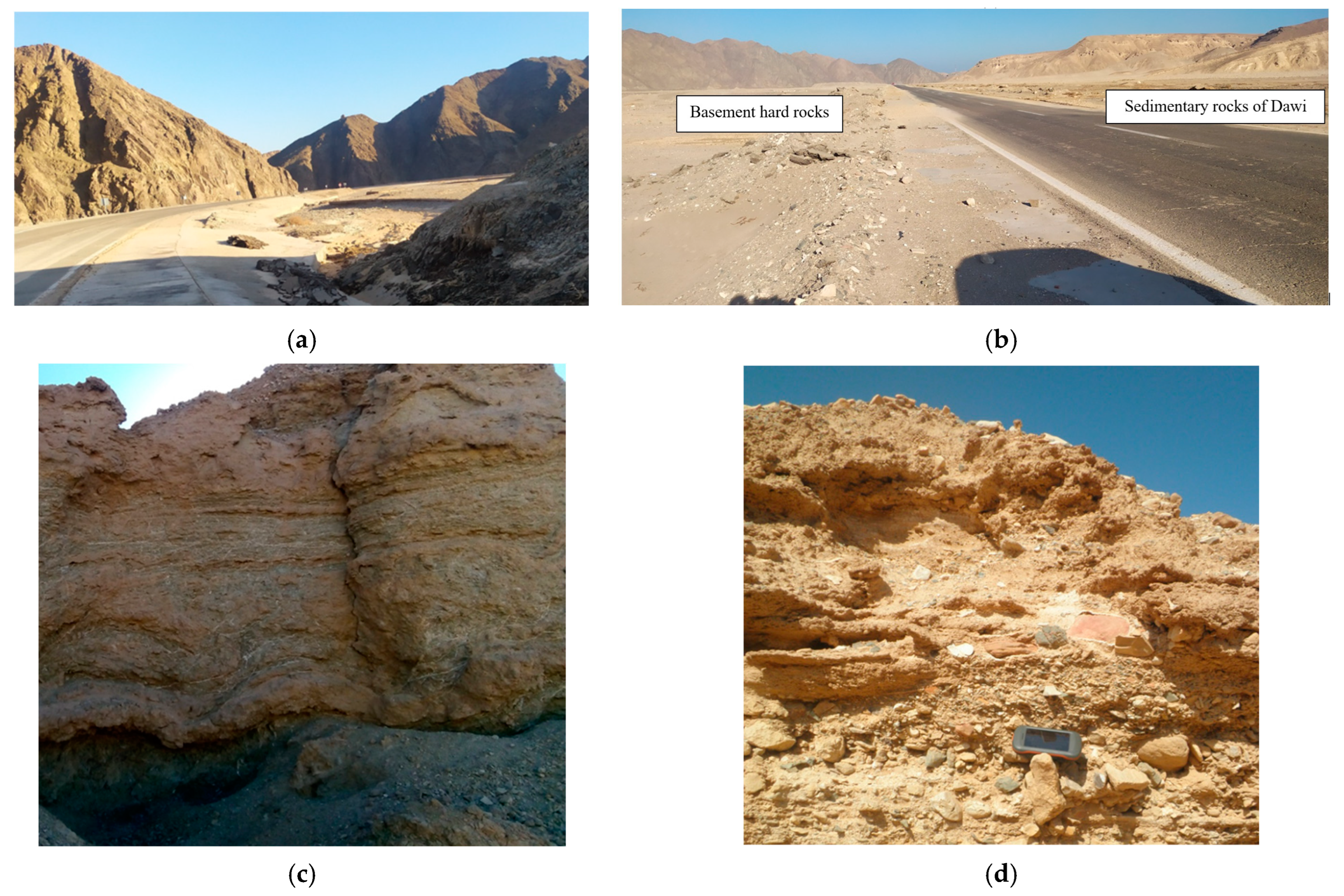

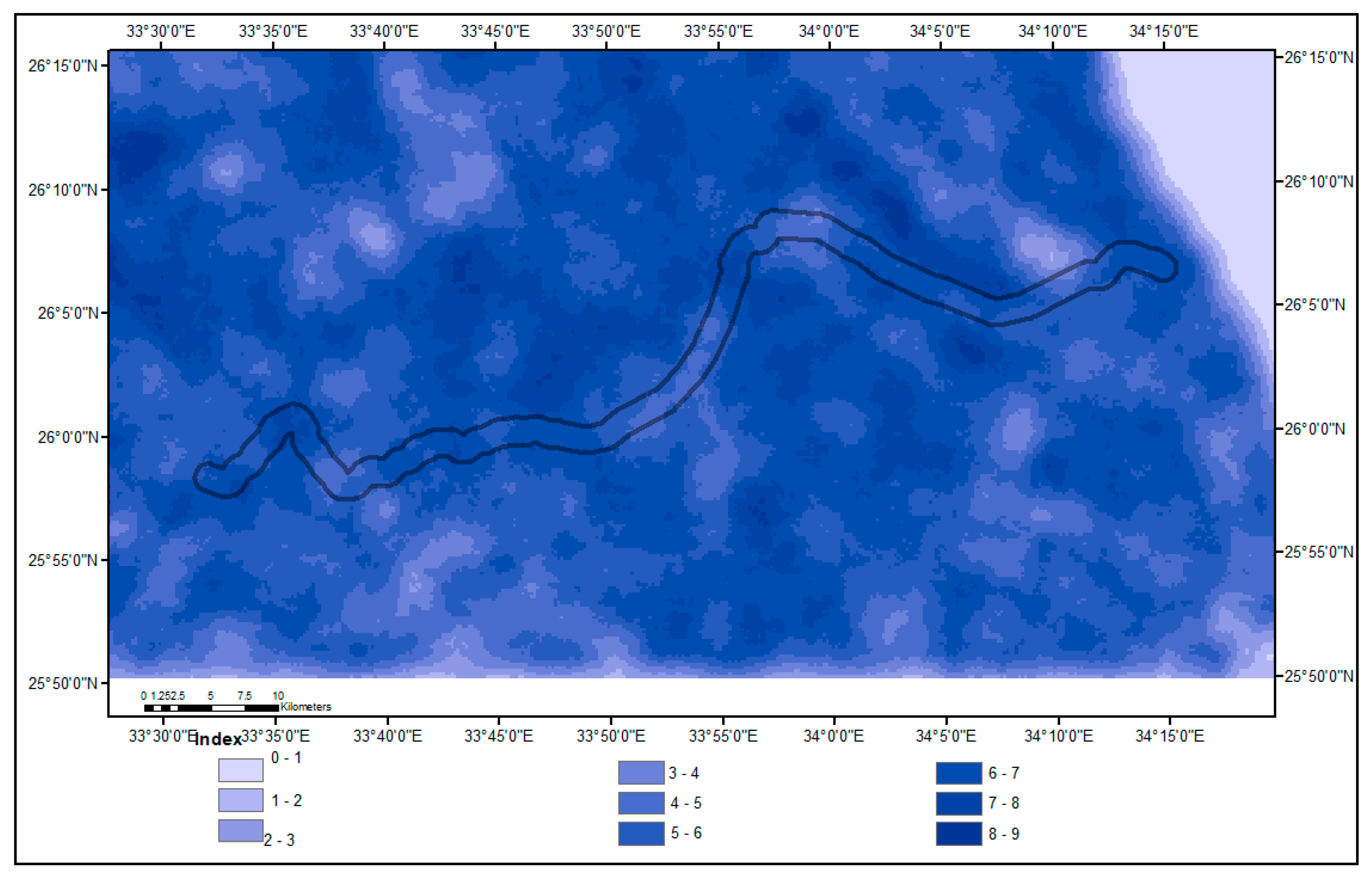

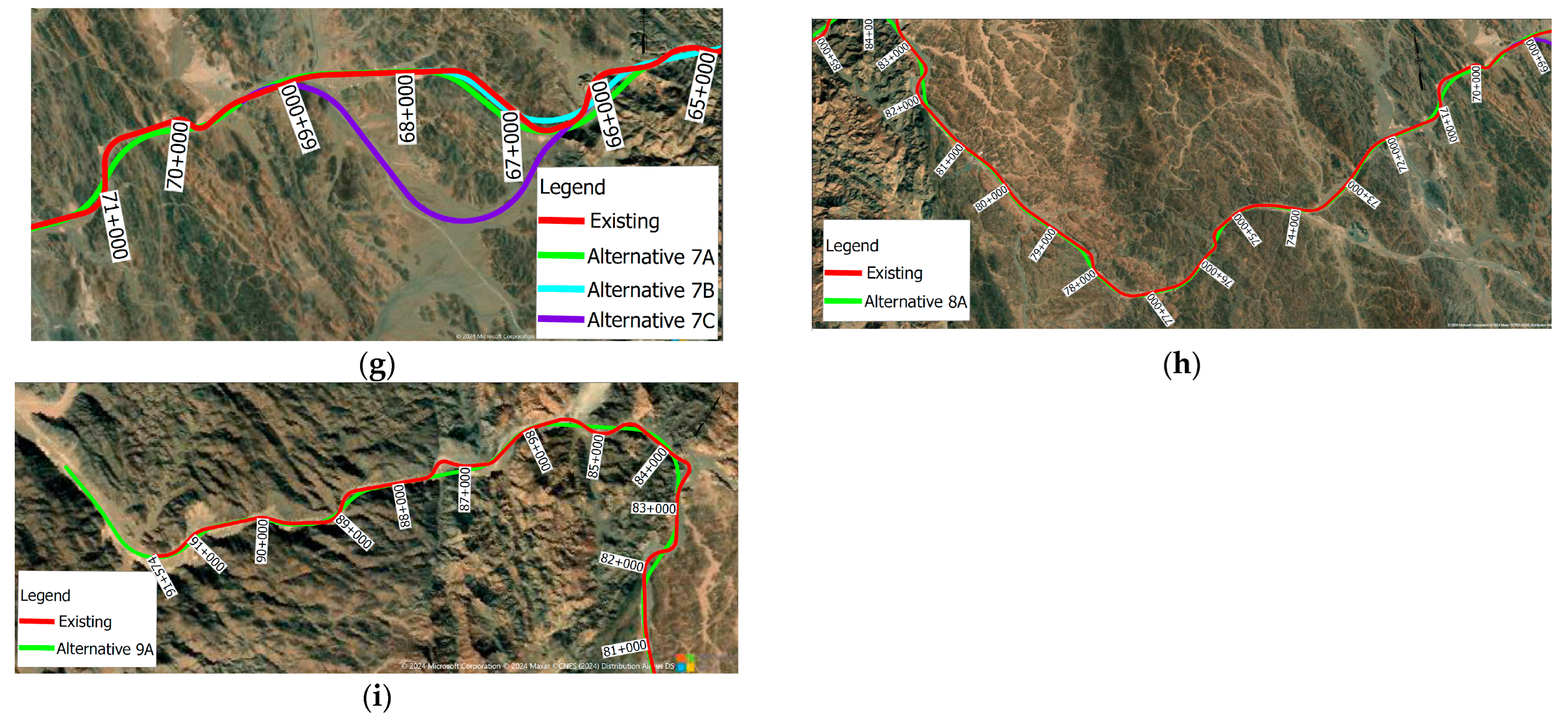
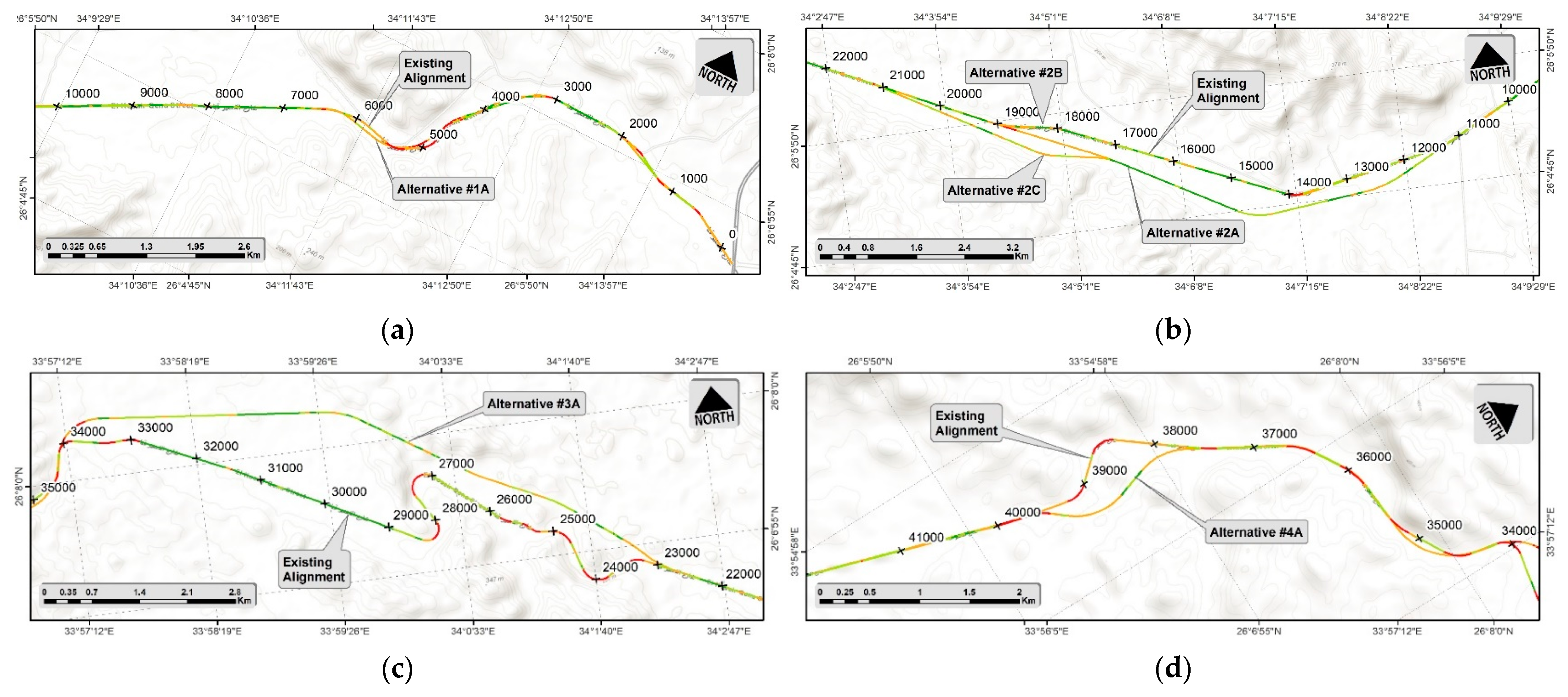
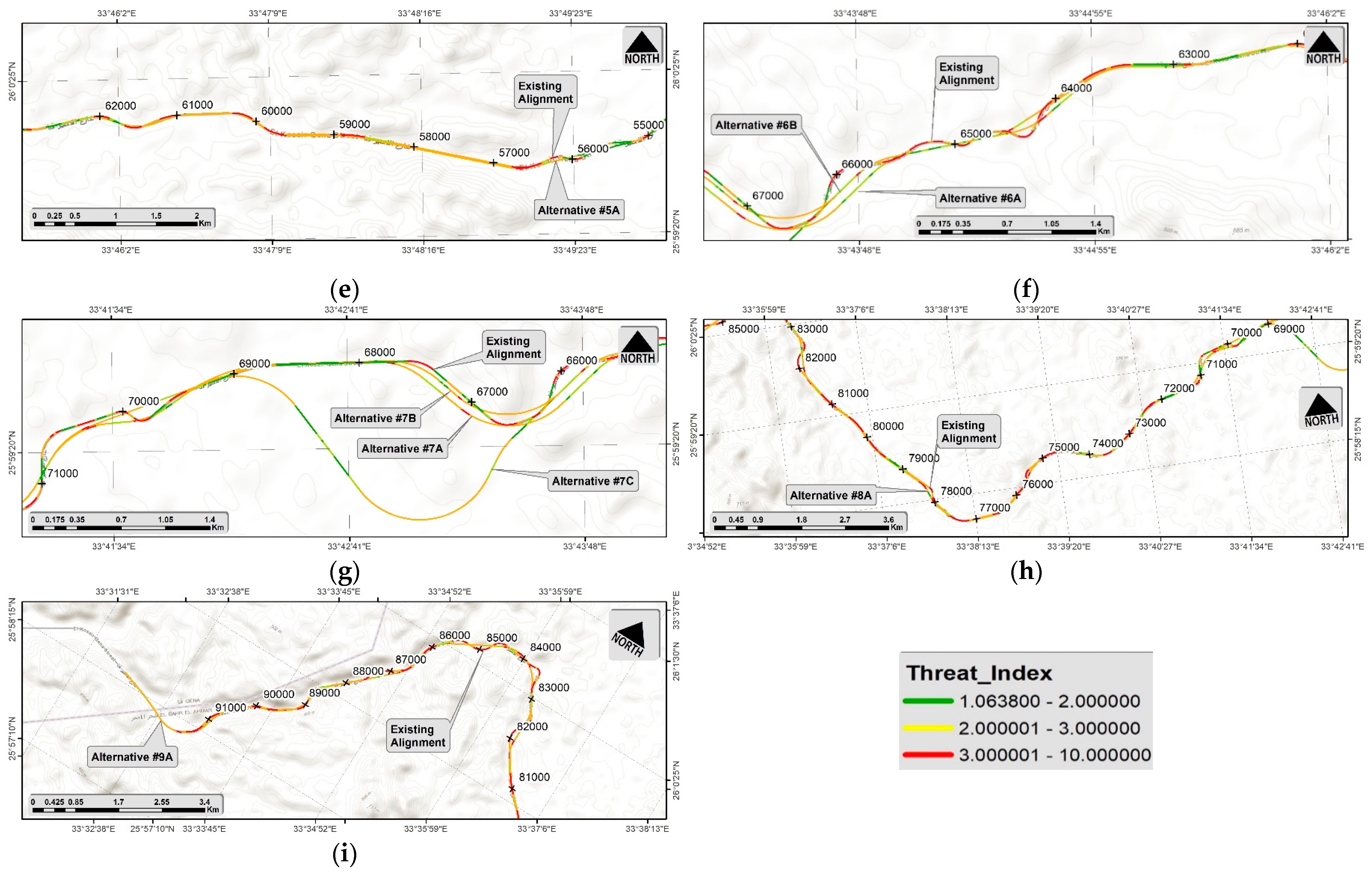
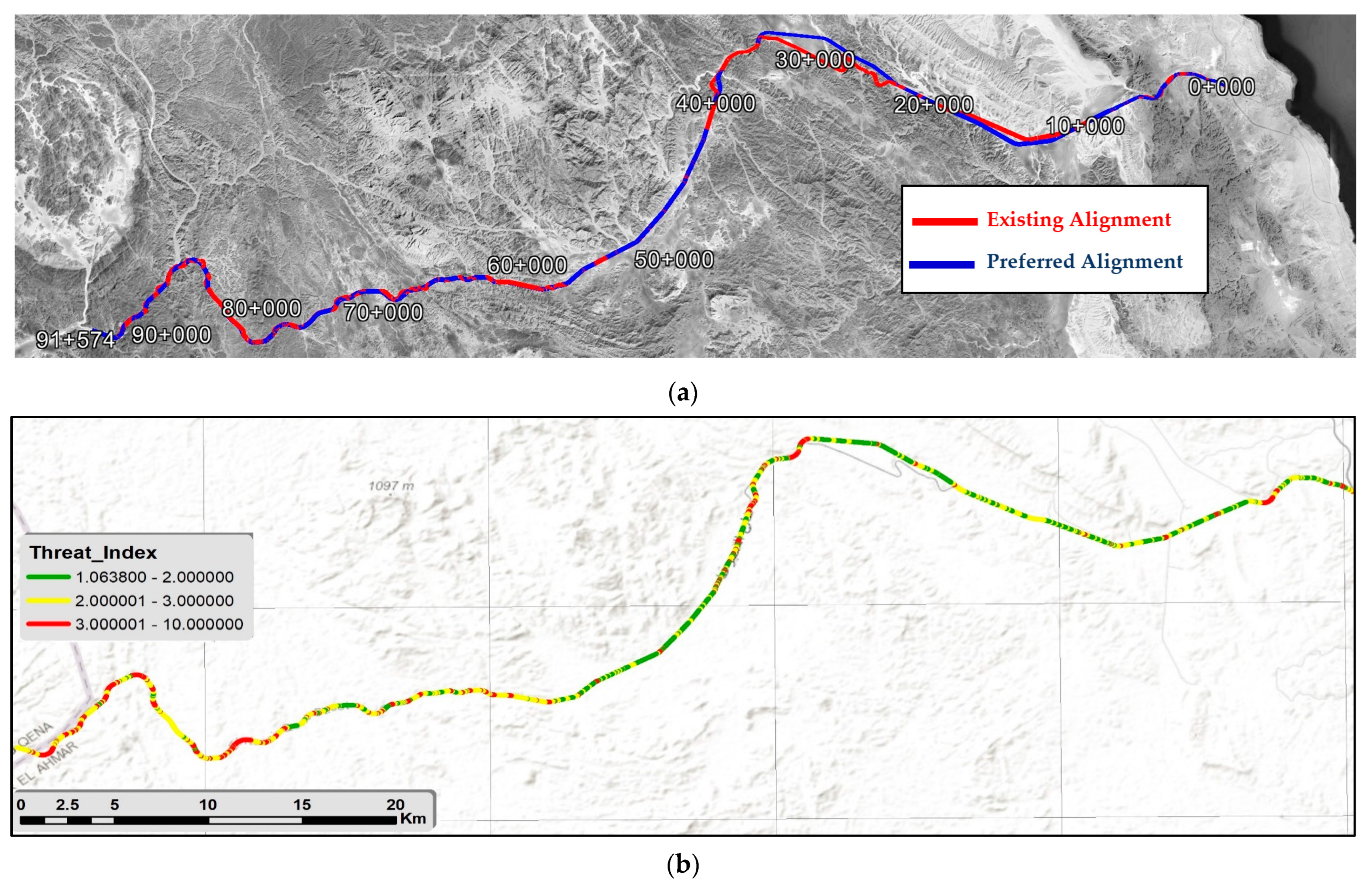

| No. | Design Risk Factors (DFi) | Risk Factor Ranges | Risk Intensity (RIN) (1–10) | Distributing Influence (Di) | Receiving Influence (Rj) | Relative Importance (qi) | Net Effect (ni) | Weight (wi) | |
|---|---|---|---|---|---|---|---|---|---|
| 1 | Tangent length | Lt (m) | Between reverse curves | 0.000 | 0.000 | 0.000 | 0.000 | 0.051 | |
| Lt < 2 V | 6 | ||||||||
| 2 V ≤ Lt < 20 V | 2 | ||||||||
| Between curves in same direction | |||||||||
| Lt < 6 V | 6 | ||||||||
| 6 V ≤ Lt < 20 V | 2 | ||||||||
| Lt ≥ 20 V | 6 | ||||||||
| 2 | Horizontal Curve Radius | Ri (m) | Ri < 600 | 10 | 1.500 | 0.500 | 2.000 | 1.000 | 0.090 |
| 600 ≤ Ri < 1000 | 8 | ||||||||
| 1000 ≤ Ri < 5500 | 2 | ||||||||
| Ri ≥ 5500 | 1 | ||||||||
| 3 | Deflection Angle | D (°) | Δ < 5 | 10 | 0.000 | 1.833 | 1.833 | −1.833 | 0.088 |
| 5 ≤ Δ < 10 | 8 | ||||||||
| 10 ≤ Δ < 15 | 4 | ||||||||
| 15 ≤ Δ < 25 | 2 | ||||||||
| Δ > 25 | 8 | ||||||||
| 4 | Horizontal Curve Length | Lh (m) | Lh < 200 | 10 | 0.833 | 0.500 | 1.333 | 0.333 | 0.081 |
| 200 ≤ Lh < 600 | 8 | ||||||||
| 600 ≤ Lh < 2500 | 2 | ||||||||
| Lh ≥ 2500 | 6 | ||||||||
| 5 | Vertical alignment grade difference | A (%) | A < 1 | 2 | 0.000 | 1.833 | 1.833 | −1.833 | 0.088 |
| 1 ≤ A < 2 | 6 | ||||||||
| 2 ≤ A < 3 | 8 | ||||||||
| A ≥ 3 | 10 | ||||||||
| 6 | Longitudinal grade | G (%) | 0 ≤ G < 0.3 | 6 | 0.667 | 0.500 | 1.167 | 0.167 | 0.078 |
| 0.3 ≤ G < 3 | 2 | ||||||||
| G ≥ 3 | 10 | ||||||||
| 7 | Slope length | Lp (m) | Lp < 300 | 6 | 0.000 | 0.500 | 0.500 | −0.500 | 0.064 |
| 300 ≤ Lp < 700 | 2 | ||||||||
| Lp ≥ 700 | 6 | ||||||||
| 8 | Crest curve parameter | kc (m) | Rci < 7400 | 10 | 0.333 | 0.000 | 0.333 | 0.333 | 0.060 |
| 7400 ≤ Rci < 15,000 | 6 | ||||||||
| Rci ≥ 15,000 | 1 | ||||||||
| 9 | Sag curve parameter | ks (m) | Rsi < 5500 | 10 | 0.333 | 0.000 | 0.333 | 0.333 | 0.060 |
| 5500 ≤ Rsi < 11,000 | 6 | ||||||||
| Rsi ≥ 11,000 | 1 | ||||||||
| 10 | Vertical curve length | Lv (m) | Lv < 70 | 10 | 0.000 | 0.667 | 0.667 | −0.667 | 0.068 |
| 70 ≤ Lv < 110 | 6 | ||||||||
| Lv ≥ 110 | 1 | ||||||||
| 11 | Flood Hazard | H (-) | Table 2 | 0.667 | 0.000 | 0.667 | 0.667 | 0.068 | |
| 12 | Road Infrastructure Flood Hazard | I (-) | I ≥ 0.5 | 10 | 0.667 | 0.000 | 0.667 | 0.667 | 0.068 |
| I < 0.5 | 5 | ||||||||
| 13 | Lithology Type | Lit (-) | Table 3 | 0.667 | 0.000 | 0.667 | 0.667 | 0.068 | |
| 14 | Lineament Density | LiD (%) | Table 4 | 0.667 | 0.000 | 0.667 | 0.667 | 0.068 | |
| Hazard Level | Description |
|---|---|
| 1 | Generally safe for people, vehicles, and buildings |
| 2 | Unsafe for small vehicles |
| 3 | Unsafe for vehicle and vulnerable people |
| 4 | Unsafe for people and vehicle |
| 5 | Unsafe for people, vehicles and some buildings |
| 6 | Unsafe for people, vehicles and all buildings |
| Rock Type | Rock Category | Risk Index | Score |
|---|---|---|---|
| Pink Granite | Very hard massive | Very High | 9–10 |
| Hammam sediments group | Hard | High | 7–8 |
| Meta volcanics | Hard | High | 7 |
| Gray Granite fractured | Hard | High | 7 |
| Mélange | Hard mixed composite | High | 5–6 |
| Sediments | Hard to soft | Moderate | 3–4 |
| Wadi deposits | Loose and Soft | Low | 2–1 |
| Lineament Density | Properties | Score |
|---|---|---|
| 0–0.000460876 | Very low | 9–10 |
| 0.000460876–0.000938212 | Low | 8 |
| 0.000938212–0.001399088 | Low-Medium | 7 |
| 0.001399088–0.001859964 | Medium-Low | 6 |
| 0.001859964–0.0023373 | Medium | 5 |
| 0.0023373–0.002798176 | Medium to High | 4 |
| 0.002798176–0.003259052 | High | 3 |
| 0.003259052–0.003736388 | High | 1–2 |
| 0.003736388–0.004197264 | Very High | 1 |
| Design Risk Factors (DFi) | No. of Elements | Minimum Value | Maximum Value | Mean Value | Standard Deviation | |
|---|---|---|---|---|---|---|
| Tangent Length | Lt (m) | 125 | 38.86 | 2158.5 | 515.06 | 518.02 |
| Horizontal Curve Radius | Ri (m) | 126 | 90 | 10,000 | 1657.1 | 3025.36 |
| Horizontal Curve Length | Lh (m) | 126 | 15.5 | 538.34 | 215.8057 | 121.08 |
| Angle of Deflection | D (°) | 126 | 0.026 | 160.65 | 34.58425 | 29.19 |
| Gradients | G (%) | 453 | ±0.04% | ±4.5% | 0.36% | 0.93% |
| Elevations | (m) | 453 | 30.05 | 546.25 m | 283.41 | 140 |
| Vertical Alignment Grade Difference | A (%) | 453 | 0.03% | 5.8% | 1% | 1.03% |
| Slope Length | Lp (m) | 453 | 56.31 | 2078 | 700 | 421 |
| Road Length in Contact with Flood Hazard | H | 88 Km | 1 | 6 | 4.4 | 1.4 |
| KP From | KP To | Alternatives | Threat Scores | ||
|---|---|---|---|---|---|
| Min | Max | Avg | |||
| 0+000 | 10+000 | Existing | 1.12 | 5.44 | 2.69 |
| Alternative 1A | 0.53 | 4.68 | 2.27 | ||
| 10+000 | 22+000 | Existing | 1.39 | 3.83 | 1.92 |
| Alternative 2A | 0.86 | 3.16 | 1.69 | ||
| Alternative 2B | 1.54 | 3.94 | 2.07 | ||
| Alternative 2C | 1.06 | 2.95 | 1.88 | ||
| 22+000 | 33+000 | Existing | 0.9 | 5.15 | 2.23 |
| Alternative 3A | 0.92 | 4.58 | 1.86 | ||
| 33+000 | 40+000 | Existing | 1.7 | 4.65 | 3.08 |
| Alternative 4A | 1.27 | 3.98 | 2.95 | ||
| Alternative 4B | 1.61 | 4.15 | 2.86 | ||
| 55+000 | 61+500 | Existing | 0.99 | 4.62 | 2.75 |
| Alternative 5A | 1.22 | 4.16 | 2.55 | ||
| 61+500 | 64+000 | Existing | 1.12 | 5.52 | 3.41 |
| Alternative 6A | 1.17 | 3.57 | 2.15 | ||
| Alternative 6B | 1.52 | 4.75 | 2.46 | ||
| 64+000 | 68+000 | Existing | 0.26 | 4.39 | 2.54 |
| Alternative 7A | 1.12 | 4.06 | 2.42 | ||
| Alternative 7B | 1.02 | 4.39 | 2.54 | ||
| Alternative 7C | 1.11 | 3.78 | 2.42 | ||
| 68+000 | 80+000 | Existing | 0.95 | 6.42 | 2.99 |
| Alternative 8A | 1.31 | 4.68 | 2.9 | ||
| 80+000 | 90+000 | Existing | 0.72 | 6.12 | 3.33 |
| Alternative 9A | 0.53 | 4.05 | 2.64 | ||
| 0+000 | 90+000 | Existing | 0.72 | 6.42 | 2.47 |
| Preferred Alignment | 0.53 | 4.68 | 2.27 | ||
Disclaimer/Publisher’s Note: The statements, opinions and data contained in all publications are solely those of the individual author(s) and contributor(s) and not of MDPI and/or the editor(s). MDPI and/or the editor(s) disclaim responsibility for any injury to people or property resulting from any ideas, methods, instructions or products referred to in the content. |
© 2024 by the authors. Licensee MDPI, Basel, Switzerland. This article is an open access article distributed under the terms and conditions of the Creative Commons Attribution (CC BY) license (https://creativecommons.org/licenses/by/4.0/).
Share and Cite
Said, D.; Foda, A.; Abdelhalim, A.; Elkhedr, M. Performance—Based Route Selection for Mountainous Highways: A Numerical Approach to Addressing Safety, Hydrological, and Geological Aspects. Appl. Sci. 2024, 14, 5844. https://doi.org/10.3390/app14135844
Said D, Foda A, Abdelhalim A, Elkhedr M. Performance—Based Route Selection for Mountainous Highways: A Numerical Approach to Addressing Safety, Hydrological, and Geological Aspects. Applied Sciences. 2024; 14(13):5844. https://doi.org/10.3390/app14135844
Chicago/Turabian StyleSaid, Dalia, Ahmed Foda, Ahmed Abdelhalim, and Mustafa Elkhedr. 2024. "Performance—Based Route Selection for Mountainous Highways: A Numerical Approach to Addressing Safety, Hydrological, and Geological Aspects" Applied Sciences 14, no. 13: 5844. https://doi.org/10.3390/app14135844





